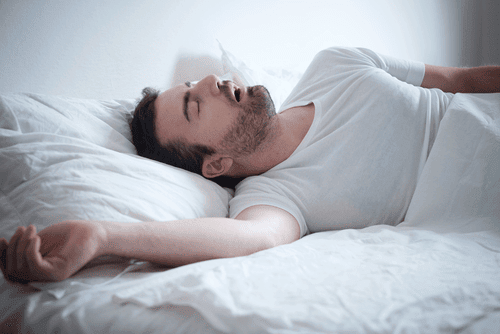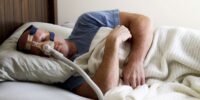Can Sleep Apnea Cause Chronic Headaches?

Sleep apnea is a common sleep disorder characterized by repeated interruptions in breathing during sleep. While it is widely recognized that sleep apnea can have adverse effects on overall health, its association with chronic headaches is still a topic of debate.
This article aims to explore the potential link between sleep apnea and chronic headaches, shedding light on the current understanding of this relationship. It will delve into the underlying mechanisms that may contribute to the development of headaches in individuals with sleep apnea, as well as discuss the diagnosis and treatment options available.
Additionally, the article will highlight the impact of sleep apnea on overall health and the importance of managing this condition. Furthermore, it will address the prevalence of sleep apnea in children and adolescents and emphasize the significance of seeking professional help for proper evaluation and management.
By providing evidence-based information, this article aims to enhance understanding and awareness of the potential association between sleep apnea and chronic headaches.
Key Takeaways
- The association between sleep apnea and chronic headaches is still debated.
- Continuous positive airway pressure (CPAP) therapy can alleviate headaches in some individuals with sleep apnea.
- Undiagnosed and untreated sleep apnea can increase the risk of cardiovascular disease and cognitive impairments.
- Incorporating lifestyle changes, maintaining a regular sleep schedule, and practicing relaxation techniques can help alleviate headache symptoms.
Understanding Sleep Apnea
Sleep apnea is a sleep disorder characterized by frequent pauses in breathing during sleep, which can lead to various health complications. It is estimated that approximately 9% of adults suffer from this disorder.
The most common type of sleep apnea is obstructive sleep apnea (OSA), where the airway becomes partially or completely blocked during sleep. This obstruction causes a decrease in oxygen levels, resulting in brief awakenings throughout the night to restore normal breathing.
Individuals with sleep apnea often experience excessive daytime sleepiness, loud snoring, and morning headaches. The relationship between sleep apnea and chronic headaches is believed to be multifactorial, with factors such as oxygen deprivation, changes in blood flow, and inflammation playing a role.
Treatment options for sleep apnea, such as continuous positive airway pressure (CPAP) therapy, have been shown to alleviate headaches in some individuals, highlighting the importance of addressing sleep apnea in the management of chronic headaches.
The Link Between Sleep Apnea and Headaches
The relationship between sleep apnea and persistent head pain has been investigated extensively. Several studies have found a significant link between the two conditions.
Sleep apnea is a breathing disorder characterized by repetitive pauses in breathing during sleep. These pauses can result in oxygen deprivation and fragmented sleep. It is believed that the reduction in oxygen levels and disrupted sleep patterns associated with sleep apnea can trigger headaches.
Furthermore, the repetitive episodes of low oxygen levels can lead to inflammation and vascular changes, which can contribute to the development of chronic headaches.
In addition, the frequent awakenings caused by sleep apnea can disrupt the normal sleep-wake cycle, leading to sleep deprivation and increased vulnerability to headaches.
Although more research is needed to fully understand the underlying mechanisms, addressing sleep apnea through appropriate treatments like continuous positive airway pressure (CPAP) therapy may help alleviate chronic headaches in individuals with this condition.
Diagnosis and Treatment of Sleep Apnea
One important aspect of addressing sleep apnea is accurate diagnosis followed by appropriate treatment options. The diagnosis of sleep apnea involves various methods, including a thorough medical history, physical examination, and sleep studies. Sleep studies, such as polysomnography, are considered the gold standard for diagnosing sleep apnea. They involve monitoring various physiological parameters during sleep, such as airflow, oxygen levels, and brain activity. Treatment options for sleep apnea vary depending on the severity of the condition. Continuous positive airway pressure (CPAP) therapy is often the first-line treatment and involves wearing a mask that delivers pressurized air to keep the airway open during sleep. Other treatment options may include oral appliances, lifestyle modifications, and in some cases, surgery. It is important for individuals with sleep apnea to undergo proper diagnosis and receive appropriate treatment to alleviate symptoms and improve their overall quality of life.
| Diagnosis Methods | Treatment Options | |||
|---|---|---|---|---|
| Medical history and physical examination | Continuous positive airway pressure (CPAP) therapy | |||
| Sleep studies (polysomnography) | Oral appliances | |||
| Monitoring airflow, oxygen levels, and brain activity during sleep | Lifestyle modifications | |||
| Surgery | Surgery | is considered as a last resort for the treatment of sleep apnea when other non-invasive methods have been unsuccessful in improving symptoms and quality of sleep. |
Impact of Sleep Apnea on Overall Health
Undiagnosed and untreated sleep apnea has been shown to have significant negative effects on an individual’s overall health, including an increased risk of cardiovascular disease and cognitive impairments.
Sleep apnea, characterized by periodic interruptions in breathing during sleep, leads to a decrease in oxygen levels and disrupted sleep patterns. These physiological disturbances can have wide-ranging consequences on various bodily systems.
The repeated drops in oxygen levels during sleep apnea episodes can cause oxidative stress, inflammation, and endothelial dysfunction, all of which contribute to the development of cardiovascular disease.
Additionally, the fragmented sleep resulting from sleep apnea can lead to daytime sleepiness and impaired cognitive function, affecting memory, attention, and decision-making abilities.
Therefore, it is crucial to diagnose and treat sleep apnea promptly to mitigate its detrimental effects on overall health.
Lifestyle Changes to Manage Sleep Apnea
Implementing certain lifestyle changes can play a crucial role in managing and alleviating the symptoms of sleep apnea, ultimately improving overall quality of life.
One important lifestyle change is maintaining a healthy weight. Obesity is a known risk factor for sleep apnea, and losing weight can significantly reduce the severity of the condition.
Regular exercise is also beneficial, as it helps strengthen the muscles involved in breathing and can improve sleep quality.
Additionally, avoiding alcohol and sedatives, especially before bedtime, can prevent the relaxation of the throat muscles that contribute to sleep apnea.
Sleeping on your side instead of your back can also help keep the airway open.
Finally, establishing a regular sleep schedule and creating a comfortable sleep environment can promote better sleep and reduce sleep apnea symptoms.
Managing Chronic Headaches
This discussion will focus on managing chronic headaches through various approaches.
Over-the-counter pain relief options, such as nonsteroidal anti-inflammatory drugs (NSAIDs), can provide temporary relief for headaches.
Additionally, stress management techniques, such as relaxation exercises and mindfulness meditation, may help reduce the frequency and intensity of chronic headaches.
If chronic headaches persist or worsen, it is advisable to seek medical advice for further evaluation and potential treatment options.
Over-the-Counter Pain Relief
Over-the-counter pain relief options are commonly used to manage chronic headaches potentially caused by sleep apnea. These medications are easily accessible and do not require a prescription, making them an attractive choice for individuals seeking relief from their symptoms. However, it is important to note that over-the-counter pain relief may only provide temporary relief and may not address the underlying cause of the headaches. It is recommended to consult with a healthcare professional to properly diagnose and treat sleep apnea, as this can significantly reduce the frequency and severity of headaches. Additionally, incorporating lifestyle changes such as maintaining a regular sleep schedule, avoiding alcohol and caffeine, and practicing relaxation techniques may also help alleviate headache symptoms.
| Pros | Cons | Recommendations |
|---|---|---|
| Easy to access | Temporary relief | Consult healthcare professional |
| Cost-effective | May not address underlying cause | Incorporate lifestyle changes |
| Various options available | Potential side effects | Maintain regular sleep schedule |
| Can be used as needed | Limited efficacy | Avoid alcohol and caffeine |
| Widely available | Practice relaxation techniques |
Stress Management Techniques
One effective approach to managing the symptoms associated with sleep apnea is through the utilization of stress management techniques. Sleep apnea is a sleep disorder characterized by pauses in breathing during sleep. Chronic headaches are a common symptom experienced by individuals with sleep apnea. Stress has been identified as a contributing factor to the development and exacerbation of sleep apnea symptoms.
Therefore, incorporating stress management techniques into the treatment plan can be beneficial. These techniques may include relaxation exercises, such as deep breathing and progressive muscle relaxation, as well as mindfulness-based practices like meditation or yoga. These techniques aim to reduce stress levels, promote relaxation, and improve sleep quality, ultimately alleviating the frequency and intensity of chronic headaches associated with sleep apnea.
It is important for individuals with sleep apnea to consult with healthcare professionals for appropriate guidance and recommendations regarding stress management techniques.
Seeking Medical Advice
Consulting with healthcare professionals is essential for individuals experiencing symptoms of sleep apnea in order to receive appropriate medical advice and guidance. Seeking medical advice is crucial because healthcare professionals can provide an accurate diagnosis, recommend appropriate treatment options, and offer ongoing support.
When individuals consult with healthcare professionals about their sleep apnea symptoms, they can expect the following benefits:
- Accurate Diagnosis:
- Healthcare professionals can conduct thorough assessments and diagnostic tests to confirm the presence of sleep apnea.
- They can differentiate between different types of sleep apnea, such as obstructive sleep apnea and central sleep apnea.
- Treatment Recommendations:
- Healthcare professionals can recommend suitable treatment options based on the severity and underlying causes of sleep apnea.
- They may suggest lifestyle modifications, such as weight loss or sleep position changes, or prescribe medical interventions like continuous positive airway pressure (CPAP) therapy.
- Ongoing Support:
- Healthcare professionals can provide ongoing monitoring and support to ensure the effectiveness of treatment.
- They can address any concerns or side effects that may arise during the management of sleep apnea.
Seeking medical advice from healthcare professionals is vital for individuals experiencing symptoms of sleep apnea. Their expertise can lead to an accurate diagnosis, appropriate treatment recommendations, and ongoing support throughout the management of sleep apnea.
Sleep Apnea in Children and Adolescents
This discussion will focus on sleep apnea in children and adolescents, specifically exploring three key points: symptoms and diagnosis, impact on learning and behavior, and treatment options.
Symptoms of pediatric sleep apnea may include snoring, restless sleep, and frequent awakening. Diagnosis often involves a sleep study to measure the frequency and severity of breathing disturbances.
The impact of sleep apnea on learning and behavior can be significant, with children experiencing difficulties in attention, memory, and academic performance.
Treatment options for pediatric sleep apnea may include lifestyle changes, such as weight loss and positional therapy, as well as the use of continuous positive airway pressure (CPAP) machines or surgical interventions.
Symptoms and Diagnosis
Symptoms of sleep apnea often include chronic headaches, which can be an indicator for diagnosis. Sleep apnea is a sleep disorder characterized by repeated pauses in breathing during sleep. It is more commonly observed in adults, but it can also affect children and adolescents.
The most common symptoms of sleep apnea in children and adolescents include:
- Loud snoring
- Gasping or choking during sleep
- Restless sleep
- Morning headaches
- Excessive daytime sleepiness
- Difficulty paying attention
However, these symptoms can be nonspecific and easily attributed to other conditions. Therefore, a proper diagnosis requires a comprehensive evaluation, including a detailed medical history, physical examination, and sleep study.
It is crucial to recognize and address sleep apnea in children and adolescents to prevent long-term complications and improve their overall well-being.
Impact on Learning and Behavior
The presence of sleep apnea in children and adolescents has been found to significantly impact their ability to learn and exhibit appropriate behavior. Sleep apnea is characterized by disrupted breathing during sleep, leading to oxygen deprivation and fragmented sleep patterns. These disturbances can result in daytime sleepiness and fatigue, which have been shown to impair cognitive function and academic performance.
Additionally, sleep apnea has been associated with behavioral problems such as hyperactivity, impulsivity, and inattentiveness. These symptoms can mimic attention deficit hyperactivity disorder (ADHD), leading to misdiagnosis and inappropriate treatment.
Furthermore, the chronic sleep disruption caused by sleep apnea can negatively affect mood regulation and emotional well-being, further contributing to learning difficulties and behavioral challenges. Therefore, early identification and treatment of sleep apnea in children and adolescents is crucial to mitigate its impact on learning and behavior.
Treatment Options for Pediatric Sleep Apnea
Treatment options for pediatric sleep apnea include lifestyle modifications, such as weight loss and regular exercise, as well as the use of continuous positive airway pressure (CPAP) devices and surgical interventions.
- Lifestyle modifications:
- Weight loss: Reducing excess weight can help alleviate symptoms of sleep apnea by decreasing the amount of tissue that may obstruct the airway during sleep.
- Regular exercise: Engaging in physical activity can aid in weight loss and improve overall cardiovascular health, which can have a positive impact on sleep apnea.
- CPAP devices:
- Continuous positive airway pressure (CPAP) machines deliver a steady flow of air pressure through a mask, helping to keep the airway open during sleep.
- CPAP therapy is often recommended as the first-line treatment for pediatric sleep apnea, as it can effectively manage symptoms and improve sleep quality.
- Surgical interventions:
- In some cases, surgical procedures may be necessary to remove enlarged tonsils or adenoids that are obstructing the airway.
- Other surgical options include jaw advancement surgery or tracheostomy, although these are typically reserved for more severe cases or when other treatments have failed.
Overall, a combination of lifestyle modifications, CPAP therapy, and surgical interventions can help manage and improve pediatric sleep apnea.
Seeking Professional Help
Seeking professional help for sleep apnea can provide individuals suffering from chronic headaches with a comprehensive evaluation and expert guidance towards effective management. Consulting a healthcare professional, such as a sleep medicine specialist or an otolaryngologist, is crucial in diagnosing and treating sleep apnea. These professionals have the expertise to conduct a thorough examination, which may involve a sleep study to assess the severity of the condition. They can also provide personalized treatment options, including continuous positive airway pressure (CPAP) therapy, oral appliances, or surgery if necessary. Furthermore, they can offer advice on lifestyle modifications such as weight loss, regular exercise, and avoiding alcohol and sedatives, which can exacerbate sleep apnea. By seeking professional help, individuals can take proactive steps towards improving their quality of sleep and reducing the frequency and intensity of chronic headaches.
| Pros of Seeking Professional Help | Cons of Not Seeking Professional Help | Emotional Impact | ||||
|---|---|---|---|---|---|---|
| Accurate diagnosis | Delayed treatment | Frustration | ||||
| Personalized treatment options | Worsening symptoms | Anxiety | ||||
| Expert guidance | Lack of improvement | Hopelessness | ||||
| Lifestyle modifications | Decreased quality of life | Desperation | ||||
| Improved sleep quality | Increased risk of complications | Relief | Support from loved ones | Overwhelmed by the situation | Comfort | |
| Medication management | Side effects of medication | Frustration | ||||
| Psychotherapy | Difficulty finding the right therapist | Empowerment | ||||
| Alternative therapies | Uncertainty about their effectiveness | Curiosity | ||||
| Self-care practices | Guilt for taking time for oneself | Self-compassion |
Frequently Asked Questions
What are the common symptoms of sleep apnea?
Common symptoms of sleep apnea include loud snoring, gasping or choking during sleep, excessive daytime sleepiness, morning headaches, difficulty concentrating, irritability, and restless sleep. Diagnosis requires a sleep study.
Can sleep apnea lead to other health complications besides headaches?
Sleep apnea can lead to several health complications besides headaches. These may include high blood pressure, heart disease, stroke, diabetes, depression, and weight gain. Proper diagnosis and treatment of sleep apnea are crucial to minimize these risks.
Are there any alternative treatments for sleep apnea besides CPAP therapy?
Alternative treatments for sleep apnea include oral appliances, positional therapy, weight loss, and surgery. These treatments can be considered in cases where continuous positive airway pressure (CPAP) therapy is not well-tolerated or ineffective.
How can I determine if my child or adolescent has sleep apnea?
Sleep apnea in children and adolescents can be diagnosed through a sleep study, which measures sleep patterns, oxygen levels, and breathing. Symptoms may include loud snoring, restless sleep, frequent awakenings, and excessive daytime sleepiness.
What should I do if I suspect I have sleep apnea but don’t have access to professional help?
If you suspect you have sleep apnea but lack access to professional help, it is important to consult with a healthcare provider to confirm the diagnosis and explore potential treatment options.











